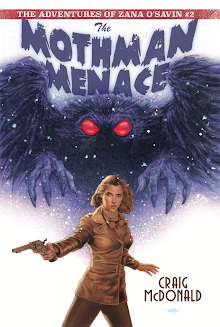The Lyon series was the forerunner of my Edgar-nominated Hector Lassiter series. Using various overlapping characters, the worlds of Hector and Chris combine—a union that will reach its apex in Chris Lyon #4, ANGELS OF DARKNESS, coming in June. (More about the Lassiter/Lyon nexus here.)
Like the Lassiter novels, the Chris Lyon novels also frequently spin from historical events. PARTS UNKNOWN is built on the still-unsolved crimes of the Cleveland "Torso-slayer," a fiend whose mutilation murders extended from the 1930s into the 1940s, and possibly several decades beyond.
The killer was pursued by legendary "Untouchable" Eliot Ness, who transitioned from harassing Al Capone to serving as Public Safety Director of Cleveland.
In addition to my novel, if you download PARTS UNKNOWN, you also get my extensive interview with James Jessen Badal, who has written two definitive accounts of the Cleveland toros murders. An excerpt of that interview follows. Download your copy of PARTS UNKNOWN now for the full interview, and, ahem, the novel...
You'll also get the first chapter of ROLL THE CREDITS, a future entry in the Hector Lassiter series, which features a certain Cleveland cop named James Hanrahan (PRINT THE LEGEND). In addition to being Hector's primary sidekick in the forthcoming Lassiter novel, he is also a key player in PARTS UNKNOWN.
INTERVIEW EXCERPT OF DISCUSSION WITH JAMES JESSEN BADAL
Tracing his movements through the V.A. system is extremely difficult.
He was a World War I vet?
Yes, he was a World War I vet. He was a medic. I quote one doctor who gives as clear a description of his odyssey as is possible. Part of the problem is fifty percent of the facilities, well, we just couldn’t find out what or where they were. He was in the Dayton psychiatric facility at least from the mid-1950s on. That’s where all of the postcards came from.
That’s fairly close to Yellow Springs. There was a Torso-style case in Yellow Springs.
I had heard that. I talked to one guy who tried to link the case to Cleveland. He wasn’t sure it was Frank Sweeney, but he was trying to bring it in because of the similarities and disposal technique and such.
The average serial killer, according to contemporary profilers, tends to fall into the twenty to thirty age-range.
Sweeney would have been older. He would have been in his forties. What complicates everything in his case is, that, yes, you can say he fits the serial killer profile to a degree, but he was a paranoid schizophrenic, and he had the manic-depressive disorder and alcoholism and drug abuse. A lot of the things I would show to the psychiatrists, and they would say, “Well, if he follows the pattern of this, this and this, then this is true, but then again, he could just have been crazy. Who knows?” That was a help...
Now, there is another recent book which puts forth the notion that there was no single killer and that these were disparate cases linked by the newspapers to sell copies... Now, that presumes there were a dozen or more people running around Cleveland beheading people.
No way. I am willing to concede that maybe even some of the canonical 12 weren’t done by the same person, but I think it’s ludicrous to say the newspapers were calling the shots. They weren’t. (Coroner Samuel) Gerber was. Gerber was far too much of an egotistical ego-maniac to allow anyone else to do that.
I have always been bothered by Gerber. In many ways, he benefitted from the crimes—not to say he committed them—but he essentially built a career around those crimes until the Sam Sheppard case came along. Then he made a name for himself with that one, until it came around with F. Lee Bailey and bit him on the other end.
Having read more newspapers than I care to think about regarding all of that, if you distinguish between the articles and the editorials: The articles—don’t get me wrong, they are filled with inaccuracies—but they were good enough in those days to always attribute what they said to someone. “So and so said...” Now, you get to some of the editorials, and, oh, this is just right out of the war between Hearst and Pulitzer. They’re just incredible. Wild stuff. In that sense, yeah, they did call the shots.
Well, there was a newspaper that was funding Ness’ cadre of secret people, right? That’s the supposition?
That’s not a supposition, that’s apparently a fact. Nobody knew that
until I wrote about it. No one knew there was that secret a group of people.
That was contained in a taped interview with David Cowles, who was the
ballistics expert of the day, the head of the forensics science department and
that was one of the things that absolutely blew our minds.







































No comments:
Post a Comment